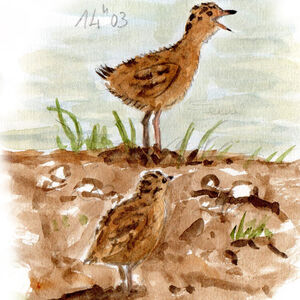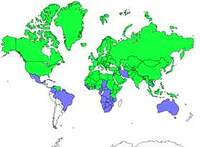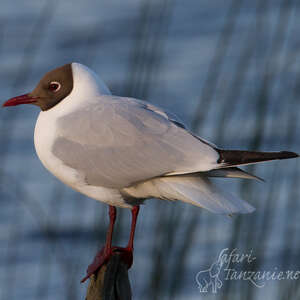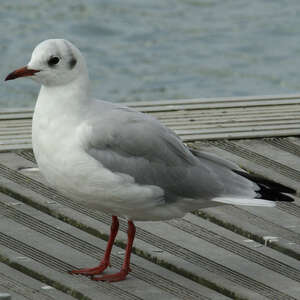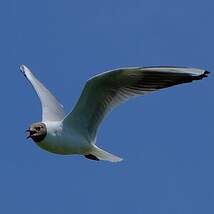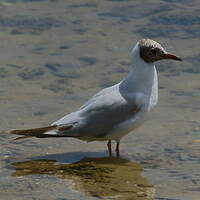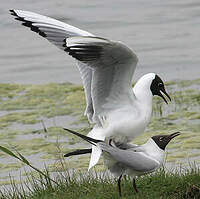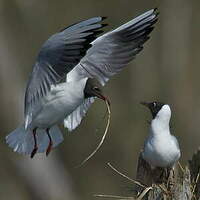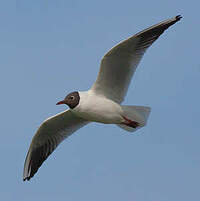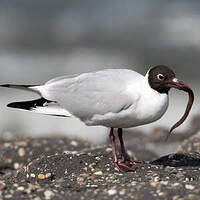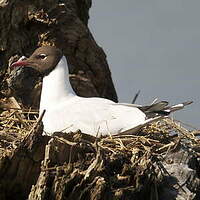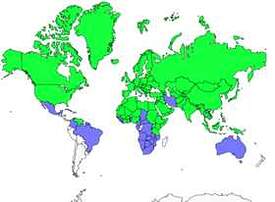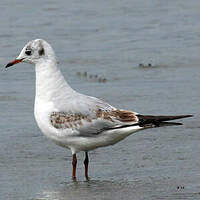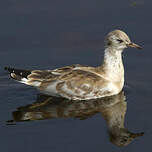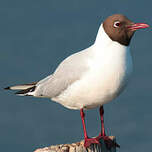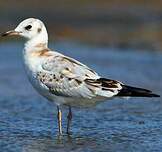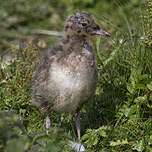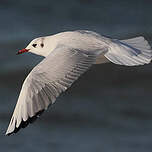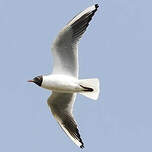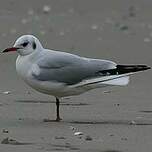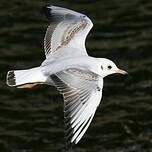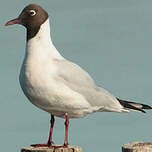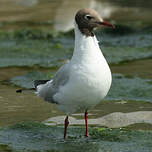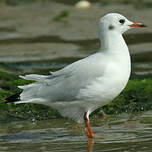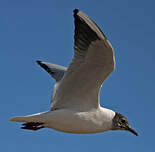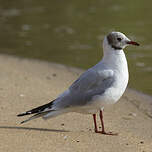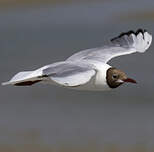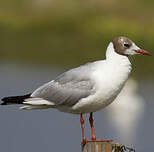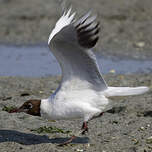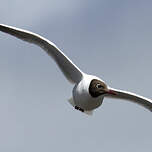Black-headed Gull
Chroicocephalus ridibundus - Mouette rieuse
Identification
The Black-headed Gull is a medium-sized, slim and elegant gull. The adult bird in breeding plumage can be identified by its dark brown cap, appearing black from a distance. It covers very little of the neck. The upperparts are fairly light grey. All the underparts are white. The black tips of the primary feathers point backwards. The tail is white. The beak and legs are dark red. Two white crescents encircle the dark eye. In flight the black and white pattern of the hand is typical. The adult bird in winter plumage has lost its cap, leaving only traces, two dark spots in front of the eye, two others behind the eyes, a faint dark band materializing the back of the cap and often another band between the eyes. From a distance, however, the head appears white. The beak and legs are a brighter red. With its dark spots on the head, the juvenile resembles the adult, but the entire upperparts have very marked brown coloration, which extends from the mantle onto the bottom of the neck, forming a hint of a collar. The tail is white and tipped black. The beak and legs are yellowish, the former with a dark tip. From the first winter, the plumage will lighten. Grey appears on the back. The brown will persist mostly on the coverts, small and medium, and on the tertiaries. The beak and legs become a bit orange. The adult plumage will not be fully developed until the bird reaches its third Civilian Year. Meanwhile, the plumage changes gradually from the original brown, an immature trait, to become increasingly grey and white. The dark brown cap is usually acquired by birds that are at least two years old. However some individuals may develop a more or less complete cap from the first summer. In such cases it is necessary to look closely at the overall plumage to detect any immature traits, such as a dark tip of the tail, before determining the age of the bird.
Subspecific information monotypic species
Foreign names
- Mouette rieuse,
- Gaviota reidora,
- garrincho-comum,
- Lachmöwe,
- dankasirály,
- Kokmeeuw,
- Gabbiano comune,
- skrattmås,
- Hettemåke,
- čajka smejivá,
- racek chechtavý,
- Hættemåge,
- naurulokki,
- Swartkopmeeu,
- gavina riallera,
- Hettumáfur,
- (mewa) śmieszka,
- lielais ķīris,
- rečni galeb,
- Озёрная чайка,
- Camar perak,
- ユリカモメ,
- 红嘴鸥,
- นกนางนวลขอบปีกขาว,
- 紅嘴鷗〔黑頭鷗〕,
Voice song and call
Habitat
Behaviour character trait
The Black-headed Gull is very gregarious outside of the breeding season. It feeds and sleeps in large groups.
This bird is an opportunist that cleans up cities and beaches, or forages in ploughed fields. Indeed, groups follow the plough and capture worms and other invertebrates. It also feeds by walking, swimming, and diving to capture fish following fishing boats. It also flies above the waves and pecks for insects at the surface. Some disputes may occur with nest neighbours, and the Black-headed Gull adopts special postures. Other displays show the bird in varied attitudes. The Black-headed Gull is monogamous and faithful to the nest site where it returns each year. It can form mixed colonies with terns. The nuptial display is at its peak when the male regurgitates food to the female. Mating takes place shortly afterwards.Flight
Dietfeeding habits
Reproduction nesting
Black-headed Gulls nest in large colonies, up to 1,000 pairs or more. The nests are about one to five metres apart. It is a fairly large nest on the ground or in low, wet vegetation. It is a shallow depression lined with vegetation. The female lays two to three olive-brown, speckled with brown eggs, towards late April-early May. Incubation lasts about 22 to 26 days. The young stay in the nest for about a week and are semi-precocial. They really leave the nest at the age of 32 to 35 days.
Threats - protection
IUCN conservation status
concern
in the Wild
threatened
evaluated
The populations of Black-headed Gulls stretch around the world, gradually colonizing other countries, from the mid-latitudes in Europe and Asia to the subarctic zones.
Sources of information
- IOC World Bird List (v14.2), Gill, F and D Donsker (Eds). 2024-04-18.
Other sources of interest
 Specification sheet created on
13/07/2023 by Jean François
Specification sheet created on
13/07/2023 by Jean FrançoisTranslation by AI Oiseaux.net
© 1996-2025 Oiseaux.net
- Accipitriformes
- Aegotheliformes
- Anseriformes
- Apodiformes
- Apterygiformes
- Bucerotiformes
- Caprimulgiformes
- Cariamiformes
- Casuariiformes
- Charadriiformes
- Ciconiiformes
- Coliiformes
- Columbiformes
- Coraciiformes
- Cuculiformes
- Eurypygiformes
- Falconiformes
- Galliformes
- Gaviiformes
- Gruiformes
- Leptosomiformes
- Mesitornithiformes
- Musophagiformes
- Nyctibiiformes
- Opisthocomiformes
- Otidiformes
- Passeriformes
- Pelecaniformes
- Phaethontiformes
- Phoenicopteriformes
- Piciformes
- Podargiformes
- Podicipediformes
- Procellariiformes
- Psittaciformes
- Pterocliformes
- Rheiformes
- Sphenisciformes
- Steatornithiformes
- Strigiformes
- Struthioniformes
- Suliformes
- Tinamiformes
- Trogoniformes

